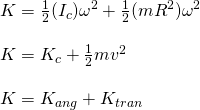Physics - Classical Mechanics - Rotation about a moving axis (Rolling motion)
[Image 1]
Introduction
Hey it's a me again @drifter1! Today we continue with Physics and more specifically the branch "Classical Mechanics" to get into the Rotation about a moving axis, which can also be called Rolling motion. So, without further ado, let's get straight into it!
Fixed Axis Rotation
Until now we mostly talked about Translational and Angular motion separately. So, an object either moved from one point to another in space (translational motion) or rotated about it's axis that was also a fixed point (angular motion). The first part has been covered a lot in earlier articles of the series. The second part is what we are covering right now in the series. Combining the terms and quantities that we studied in the previous articles about Angular motion, right now we know that an object rotates:- around a fixed axis of rotation 'O', called the pivot point
- because of a change in it's angular velocity (ω) that has been caused by a Torque (τ) that made it accelerate with some angular acceleration (a). Also think about: Στ = Ia
- wanting to keep it's "rotation state" (rotating or not)

Moving Axis Rotation
Let's now think about the combined motion of translation + rotation (rolling motion). Continuing with the expansion of the previous equation we get:
So, you can see the that kinetic energy at the point of contact is equal to the sum of Angular/Rotational and Translational kinetic energy. In this previous equation the translational motion part is of course equal to the kinetic energy of the center-of-mass (CM) and so we can also write that the total kinetic energy of a rolling body is:

This means that calculating the kinetic energy of a rolling body is quite simple! We just have to calculate the kinetic energy of it's center-of-mass and add it to the angular kinetic energy in respect to the center-of-mass. This means that we only have to know the moment of Inertia (I) about the center-of-mass, which can be found easily for common shapes.
Of course, the previous equation can be quite misleading and that's why I made the complete proof using the moment of inertia around the point of contact, where we also had to apply the Parallel Axis Theorem. We never really added the impact of the translational motion, we just tried to calculate the kinetic energy at some point different than the center-of-mass (and mostly axis of rotation). Talking about a distance of R the substitution of the term ωR gave us the tangential velocity v (which is also equal to the velocity of the center-of-mass) and so, in the end, the kinetic energy of the center-of-mass (Kcm = ½mv2). Stay Cautious!
RESOURCES:
References
- https://phys.libretexts.org/Bookshelves/Supplemental_Modules_(Physics)/Pedagogy/The_axis_of_rotation_for_rolling_motion
- https://www.dronstudy.com/book/chapter-notes-rotational-motion-and-rolling-motion-physics-class-11/4/
Images
Mathematical equations used in this article, where made using quicklatex.
Previous articles of the series
Rectlinear motion
- Velocity and acceleration in a rectlinear motion -> velocity, acceleration and averages of those
- Rectlinear motion with constant acceleration and free falling -> const acceleration motion and free fall
- Rectlinear motion with variable acceleration and velocity relativity -> integrations to calculate pos and velocity, relative velocity
- Rectlinear motion exercises -> examples and tasks in rectlinear motion
Plane motion
- Position, velocity and acceleration vectors in a plane motion -> position, velocity and acceleration in plane motion
- Projectile motion as a plane motion -> missile/bullet motion as a plane motion
- Smooth Circular motion -> smooth circular motion theory
- Plane motion exercises -> examples and tasks in plane motions
Newton's laws and Applications
- Force and Newton's first law -> force, 1st law
- Mass and Newton's second law -> mass, 2nd law
- Newton's 3rd law and mass vs weight -> mass vs weight, 3rd law, friction
- Applying Newton's Laws -> free-body diagram, point equilibrium and 2nd law applications
- Contact forces and friction -> contact force, friction
- Dynamics of Circular motion -> circular motion dynamics, applications
- Object equilibrium and 2nd law application examples -> examples of object equilibrium and 2nd law applications
- Contact force and friction examples -> exercises in force and friction
- Circular dynamic and vertical circle motion examples -> exercises in circular dynamics
- Advanced Newton law examples -> advanced (more difficult) exercises
Work and Energy
- Work and Kinetic Energy -> Definition of Work, Work by a constant and variable Force, Work and Kinetic Energy, Power, Exercises
- Conservative and Non-Conservative Forces -> Conservation of Energy, Conservative and Non-Conservative Forces and Fields, Calculations and Exercises
- Potential and Mechanical Energy -> Gravitational and Elastic Potential Energy, Conservation of Mechanical Energy, Problem Solving Strategy & Tips
- Force and Potential Energy -> Force as Energy Derivative (1-dim) and Gradient (3-dim)
- Potential Energy Diagrams -> Energy Diagram Interpretation, Steps and Example
- Internal Energy and Work -> Internal Energy, Internal Work
Momentum and Impulse
- Conservation of Momentum -> Momentum, Conservation of Momentum
- Elastic and Inelastic Collisions -> Collision, Elastic Collision, Inelastic Collision
- Collision Examples -> Various Elastic and Inelastic Collision Examples
- Impulse -> Impulse with Example
- Motion of the Center of Mass -> Center of Mass, Motion analysis with examples
- Explaining the Physics behind Rocket Propulsion -> Required Background, Rocket Propulsion Analysis
Angular Motion
- Angular motion basics -> Angular position, velocity and acceleration
- Rotation with constant angular acceleration -> Constant angular acceleration, Example
- Rotational Kinetic Energy & Moment of Inertia -> Rotational kinetic energy, Moment of Inertia
- Parallel Axis Theorem -> Parallel axis theorem with example
- Torque and Angular Acceleration -> Torque, Relation to Angular Acceleration, Example
Final words | Next up
This is actually it for today's post! Next time we will continue with the definition of Work and Power in Angular Motion....
See ya!
Keep on drifting!



This post has been voted on by the SteemSTEM curation team and voting trail in collaboration with @curie.
If you appreciate the work we are doing then consider voting both projects for witness by selecting stem.witness and curie!
For additional information please join us on the SteemSTEM discord and to get to know the rest of the community!
Hi @drifter1!
Your post was upvoted by @steem-ua, new Steem dApp, using UserAuthority for algorithmic post curation!
Your UA account score is currently 3.491 which ranks you at #6738 across all Steem accounts.
Your rank has not changed in the last three days.
In our last Algorithmic Curation Round, consisting of 200 contributions, your post is ranked at #166.
Evaluation of your UA score:
Feel free to join our @steem-ua Discord server